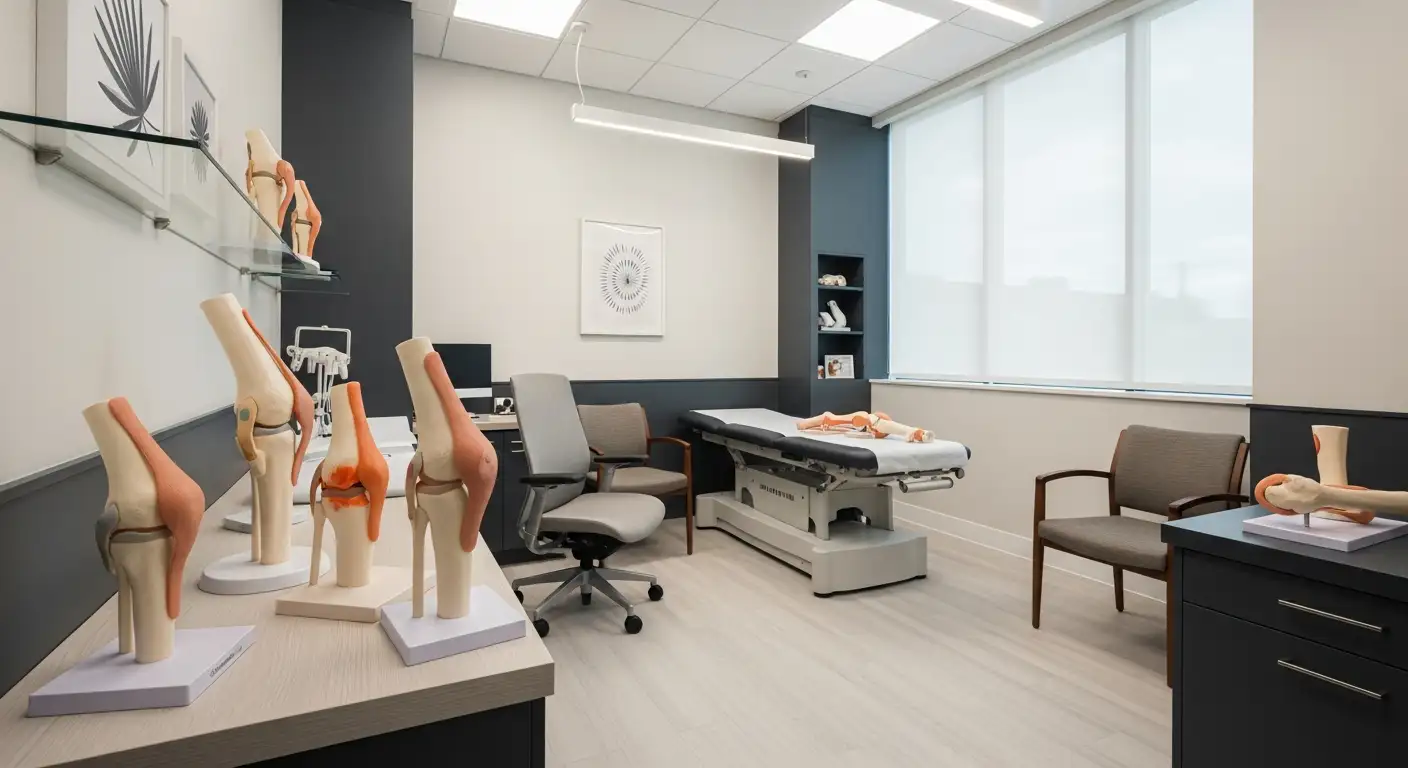Understanding How Chiropractic Care Supports Knee Health
Knee pain is a common complaint affecting individuals of all ages, often resulting from injuries, arthritis, or biomechanical imbalances. While traditional treatments include medication and surgery, chiropractic care offers a safe, non-invasive alternative that addresses the root causes of knee discomfort. By evaluating the entire musculoskeletal system and employing targeted techniques, chiropractors can help improve joint function, reduce inflammation, and promote healing. This article explores how chiropractic interventions support knee pain management, the conditions they address, and the long-term strategies for maintaining knee health.
Holistic Evaluation and Personalized Treatment Plans

How can chiropractic care support knee pain management?
Chiropractic care can support knee pain management by addressing misalignments in the spine, hips, and lower limbs that contribute to joint stress and discomfort. Techniques such as joint manipulation, mobilization, and soft tissue therapy enhance knee joint mobility, reduce inflammation, and ease pain. Chiropractors craft tailored exercises and recommend lifestyle changes to bolster the muscles that support the knee, improve flexibility, and prevent future issues. They also identify underlying causes like poor posture or muscle imbalances, offering a comprehensive approach to pain relief. This holistic method aims to restore function and promote long-term health.
What are the common causes of knee pain that chiropractic care can address?
Knee pain can stem from various issues, including ligament sprains, meniscus tears, osteoarthritis, gout, bursitis, overuse injuries, traumatic incidents, and improper movement patterns. Often, these problems are compounded by soft tissue tension, joint restrictions, or spinal misalignments that affect overall leg and knee function. Chiropractic interventions focus on evaluating and treating these musculoskeletal problems through joint adjustments, soft tissue therapies, and rehabilitative exercises. The goal is to restore proper joint mobility, reduce inflammation, and promote healing, ultimately improving knee health and preventing future injuries.
When should I seek chiropractic help for knee pain?
Seeking chiropractic assistance is advisable if knee pain persists beyond a few days or weeks, worsens, or impairs daily activities. Other signs include swelling, warmth, redness, popping sounds, instability, weakness, or difficulty extending the knee. Persistent pain following injury or associated with chronic conditions like arthritis also warrants professional evaluation. Chiropractic care can address various underlying issues such as joint misalignments and soft tissue inflammation. If the pain limits mobility or impacts quality of life, early intervention with a chiropractor can help identify causes and develop effective, individualized treatment plans.
How effective are chiropractic methods in managing knee pain?
Chiropractic techniques can be quite effective, especially when addressing underlying causes such as joint misalignment, soft tissue tension, and muscle imbalances. Common methods include spinal and joint adjustments, trigger point therapy, ultrasound, and postural correction. Evidence supports that these therapies can improve mobility, reduce inflammation, and alleviate pain related to osteoarthritis, tendinitis, ligament injuries, and bursitis. Combining chiropractic care with advanced therapies like platelet-rich plasma (PRP) injections may offer enhanced healing benefits. Overall, personalized chiropractic treatment offers a safe, non-invasive alternative to surgeries and long-term medication for many patients.
What specific assessment and treatment approaches are used?
Chiropractors perform comprehensive evaluations that include reviewing medical history, conducting physical examinations, analyzing gait and posture, and assessing joint and spinal alignment. They consider the entire kinetic chain—including the hips, ankles, and spine—that influence knee health. Diagnostic imaging might be used to identify structural issues.
Treatment strategies involve manual manipulations to realign joints, soft tissue therapies like massage and trigger point therapy to reduce tension and inflammation, and exercises to strengthen the supporting muscles. Additional approaches include ultrasound, electrical stimulation, cold laser therapy, and lifestyle advice such as ergonomic improvements and nutritional guidance. This multifaceted approach ensures the treatment targets the root causes of knee pain, aiming for sustained relief and improved function.
| Aspect | Approach/Technique | Purpose |
|---|---|---|
| Evaluation | Medical history, gait analysis, posture assessment | Identify causes and plan individualized treatment |
| Manual therapy | Joint adjustments, mobilizations, soft tissue therapy | Improve joint mobility, reduce pain |
| Therapeutic exercises | Stretching, strengthening programs | Stabilize knee, prevent future injuries |
| Additional therapies | Ultrasound, laser, electrical stimulation, massage | Reduce inflammation, promote healing |
| Lifestyle modifications | Posture correction, ergonomic advice, diet | Long-term prevention |
Why choose chiropractic care for knee problems?
Chiropractic treatment offers a drug-free, non-invasive approach tailored to each individual’s needs. It focuses on resolving musculoskeletal imbalances, improving joint mechanics, and reducing inflammation. This holistic approach not only alleviates pain but also addresses postural issues, muscle weaknesses, and biomechanical dysfunctions that contribute to knee problems.
Patients often experience improvements within a few weeks, with many benefitting from longer-term management strategies. By emphasizing the body's interconnected systems, chiropractors aim to restore normal function and prevent future issues, making chiropractic care a viable option for those seeking to avoid surgery or prolonged medication use.
Therapeutic Techniques and Modalities in Chiropractic Care

How can chiropractic care support knee pain management?
Chiropractic care can support knee pain management by targeting misalignments in the spine, hips, and lower limbs that might be contributing to joint stress and discomfort. One of the primary methods involves joint adjustments and manipulations, which are gentle, controlled movements designed to restore proper joint alignment and improve mobility.
In addition to joint adjustments, soft tissue therapies play a crucial role. Techniques such as massage and trigger point therapy help reduce muscle tension around the knee, shallow inflammation, and improve blood flow. These therapies can release tightness in muscles and ligaments that may be pulling on the knee joint.
Furthermore, chiropractors prescribe therapeutic exercises and rehabilitation programs tailored to individual needs. These exercises focus on strengthening support muscles, enhancing flexibility, and stabilizing the joint, all of which contribute to long-term relief and injury prevention.
Chiropractors also utilize various modalities, such as ultrasound, electrical stimulation, and laser therapy, to facilitate tissue healing, decrease inflammation, and reduce pain.
Overall, chiropractic care offers a comprehensive, non-invasive approach that addresses the root causes of knee pain, promotes natural healing, and improves joint function.
What are the common causes of knee pain that chiropractic care can address?
Knee pain often stems from several underlying issues, including joint injuries like ligament sprains, meniscus tears, or cartilage degeneration such as osteoarthritis. Conditions like bursitis, tendinitis, and autoimmune diseases linked to inflammation also contribute significantly.
Improper movement patterns, overuse, repetitive strain, and traumatic injuries can exacerbate these problems. Poor posture and misalignments in the spine or hips may also lead to uneven stress distribution across the knee joint.
Chiropractic care targets these causes by assessing the entire musculoskeletal system. Techniques such as joint adjustments help realign the knee, hips, or spine, alleviating abnormal stresses. Soft tissue therapies like massage and trigger point therapy reduce muscle tightness that may pull on the joint.
Additionally, therapeutic exercises strengthen muscles supporting the knee, improving stability and preventing future injuries. Addressing these issues holistically promotes better joint health and functional movement.
When should I seek chiropractic help for knee pain?
You should consider seeing a chiropractor if knee pain persists beyond a few days, worsens over time, or limits your daily activities. Immediate consultation is advised if you experience swelling, redness, warmth, or significant instability, as these could indicate more serious issues.
Signs that warrant professional evaluation include popping or clicking sounds, inability to fully extend or bend the knee, or if pain accompanies other symptoms like fever or unexplained weight loss.
Chiropractic care is particularly useful if your knee pain results from misalignment or soft tissue inflammation rather than an acute traumatic injury requiring surgical intervention. Chronic conditions such as osteoarthritis, tendinitis, or bursitis also benefit from chiropractic assessment.
If knee pain affects your mobility or quality of life, early intervention can prevent progression and help restore function more efficiently.
How effective are chiropractic methods in managing knee pain?
Chiropractic techniques are generally effective in managing various knee-related conditions—especially mechanical issues due to misalignments, inflammation, and soft tissue restrictions. Adjustments and manipulations can correct joint restrictions, restore proper movement, and reduce pain.
Studies and case reports support the effectiveness of chiropractic care in improving knee mobility and alleviating symptoms associated with osteoarthritis, ligament injuries, and inflammation.
Methods such as trigger point therapy and ultrasound therapy contribute to reducing muscle tension and inflammation, further facilitating healing. When combined with personalized exercises and lifestyle modifications, chiropractic care can lead to significant functional improvements.
While results can vary among individuals, many patients experience relief within a few weeks, with sustained benefits over longer periods. Integrating chiropractic care with other regenerative or supportive therapies might enhance outcomes further.
In conclusion, chiropractic methods provide a safe, drug-free alternative for managing knee pain, particularly when tailored to the patient’s specific condition and combined with ongoing self-care strategies.
Addressing the Underlying Causes of Knee Pain
How can chiropractic care support knee pain management?
Chiropractic care offers a holistic approach to managing knee pain by focusing on the root causes rather than just symptoms. Through detailed assessments—including reviewing medical history and evaluating movement patterns—chiropractors identify musculoskeletal imbalances, postural issues, and spinal misalignments that may contribute to knee discomfort.
Techniques such as joint adjustments, mobilization, and soft tissue therapy help improve the mobility of the knee joint, reduce inflammation, and alleviate pain. Chiropractors also develop personalized exercise programs to strengthen supporting muscles, which enhances joint stability and flexibility.
Additionally, lifestyle advice on posture, ergonomics, and body mechanics supports long-term knee health. This comprehensive approach not only relieves pain but also prevents future problems, making chiropractic care a safe, non-invasive option for knee pain management.
What are the common causes of knee pain that chiropractic care can address?
Knee pain often results from various issues like ligament sprains, meniscus tears, osteoarthritis, bursitis, and tendinitis. Overuse, improper technique during activities, traumatic injuries, and degenerative conditions are common triggers.
Chiropractic practitioners evaluate these causes by examining the entire musculoskeletal system, including the spine, hips, and foot mechanics—all of which influence knee health. They treat related soft tissue problems, joint restrictions, and misalignments through a variety of methods.
For example, if misalignments are impacting knee function, spinal or joint adjustments can restore proper movement, reducing stress on the knee. Therapies may also include soft tissue massage, stretching, and strengthening exercises to address muscle tightness and improve joint mobility.
By targeting both local and related systemic issues, chiropractic care enhances joint stability, promotes healing, and helps prevent recurrence.
When should I seek chiropractic help for knee pain?
It is advisable to seek chiropractic care if knee pain persists beyond a few days, worsens over time, or interferes with normal activities. Warning signs include swelling, redness, warmth, clicking sounds, instability, or weakness.
Persistent pain, especially if accompanied by limited range of motion or following an injury, signals the need for professional evaluation. If the pain stems from chronic conditions like arthritis or results from trauma, a chiropractor can assess whether treatment is appropriate.
Early intervention can reduce inflammation, improve joint function, and prevent progression of degeneration. If knee pain significantly affects mobility or quality of life, consulting a chiropractor promptly can facilitate tailored treatment plans and faster recovery.
How effective are chiropractic methods in managing knee pain?
Chiropractic techniques have demonstrated effectiveness in managing various causes of knee pain, including osteoarthritis, ligament injuries, and tendinitis. Adjustments, soft tissue therapies, ultrasound treatments, and posture correction contribute to restoring joint mobility and reducing inflammation.
Research and clinical experiences show that many patients experience significant symptom relief within weeks of starting treatment. Combining chiropractic care with other therapies like platelet-rich plasma (PRP) injections or rehabilitative exercises can enhance outcomes.
While the degree of benefit varies individually, chiropractic interventions are recognized as safe and non-invasive options that can complement other medical treatments. They address biomechanical issues and muscular imbalances that contribute to knee pain, supporting long-term joint health.
In summary, chiropractic management provides a practical and targeted approach to knee pain relief, emphasizing natural healing and functional restoration.
Enhancing Mobility and Function with Gentle Therapies
How can chiropractic care support knee pain management?
Chiropractic care plays a supportive role in managing knee pain by focusing on correcting musculoskeletal misalignments that increase joint stress and discomfort. Techniques such as joint mobilization and adjustments help restore proper movement to the knee joint and surrounding structures. Soft tissue therapies like massage and trigger point therapy reduce muscle tension and inflammation, aiding in pain relief and improving flexibility.
Rehabilitative exercises tailored to individual needs strengthen muscles that support the knee, which can prevent future injuries and enhance stability. Modalities such as ultrasound, low-level laser therapy, and electrical stimulation are used to accelerate tissue healing, decrease inflammation, and reduce pain levels. A thorough evaluation allows chiropractors to identify structural imbalances, poor posture, or movement patterns contributing to knee issues. This holistic approach ensures addressing both symptoms and their underlying causes, ultimately improving long-term joint function.
What are the common causes of knee pain that chiropractic care can address?
Knee pain arises from various causes, including ligament sprains, meniscus tears, osteoarthritis, bursitis, and tendinitis. Overuse injuries, improper biomechanics, trauma, and degenerative changes can also lead to persistent discomfort. Chiropractic care aims to treat these root issues by assessing regional and systemic musculoskeletal health.
Treatments focus on alleviating soft tissue tightness, restoring joint mobility, and correcting misalignments in the spine, hips, and lower limbs. Techniques such as joint adjustments and soft tissue therapies help reduce tension around the knee, improve blood flow, and promote proper movement patterns. Strengthening supporting muscles via specific exercises helps stabilize the joint and prevent recurrence.
Overall, chiropractors work to identify and address mechanical and structural contributors to knee pain, fostering a comprehensive recovery.
When should I seek chiropractic help for knee pain?
Seeking professional chiropractic help is advisable if knee pain persists beyond a few days or worsens over time. If pain limits mobility, causes swelling, redness, warmth, or instability, a detailed assessment is necessary. Unusual sounds like popping or clicking, inability to fully extend or bear weight on the knee, or pain following injury or long-term conditions like arthritis are indicators to consult a chiropractor.
Early intervention can prevent further deterioration and may involve gentle adjustments, soft tissue treatment, and rehabilitative exercises tailored to your condition. If your daily activities are impaired or the pain does not improve with rest or home care, professional evaluation ensures a precise diagnosis and effective treatment plan.
How effective are chiropractic methods in managing knee pain?
Chiropractic techniques have demonstrated effectiveness in managing various knee conditions, such as osteoarthritis, tendinitis, ligament strains, and bursitis. Adjustments can realign the joints, reduce mechanical stress, and help restore normal movement patterns.
Soft tissue therapies like trigger point releases and ultrasound therapy are valued for reducing inflammation and easing muscle tension. Some case studies and research support the positive impact of chiropractic care on knee mobility, pain reduction, and function. When combined with other treatments like regenerative therapies or corrective exercises, patient outcomes improve significantly.
While individual results vary, chiropractic care offers a non-invasive, drug-free approach that can complement other medical treatments or serve as an alternative, particularly for long-term pain management. It emphasizes addressing root causes, ensuring lasting benefits rather than temporary symptom relief.
| Aspect | Description | Additional Details |
|---|---|---|
| Techniques Used | Adjustments, soft tissue therapy, modalities | Ultrasound, laser, electrical stimulation |
| Conditions Treated | Osteoarthritis, tendinitis, ligament injuries | Bursitis, meniscus tears, patellar tendinitis |
| Goals of Treatment | Improve joint mobility, reduce inflammation | Restore function, prevent recurrence |
| Common Procedures | Joint mobilization, trigger point therapy | Rehabilitation exercises, lifestyle advice |
| Expected Outcomes | Pain reduction, increased mobility | Improved strength and stability |
Chiropractic care offers a holistic, personalized approach to knee pain, emphasizing physical health and musculoskeletal balance. Early intervention, thorough assessment, and consistent therapy can help restore knee function and enhance overall quality of life.
Supporting Long-term Knee Health through Lifestyle and Preventative Measures

How can chiropractic care support knee pain management?
Chiropractic care plays a significant role in managing knee pain by focusing on the musculoskeletal system's health and alignment. Chiropractors identify and correct misalignments in the spine, hips, and lower limbs that can put extra stress on knee joints, leading to pain and dysfunction. Through techniques such as joint manipulations, mobilization, and soft tissue therapy, they improve the mobility of the knee joint and reduce inflammation.
Furthermore, chiropractors recommend personalized exercises and lifestyle changes that strengthen the muscles supporting the knee, enhance flexibility, and prevent future injuries. They also look for underlying issues like poor posture, muscle imbalances, or incorrect movement patterns that contribute to ongoing problems.
Overall, chiropractic care offers a safe, non-invasive approach that targets the root causes of knee pain, promoting recovery and better function in the long term.
Supporting Knee Health for a Better Quality of Life
Chiropractic care offers a comprehensive and effective approach to managing knee pain by focusing on the root causes and promoting overall musculoskeletal health. Through individualized assessments, targeted adjustments, soft tissue therapies, and lifestyle modifications, chiropractors can help reduce pain, improve mobility, and prevent future issues. Incorporating chiropractic care into your long-term health strategy not only alleviates current discomfort but also supports sustained knee health, enabling you to maintain an active and pain-free lifestyle. If you experience persistent knee pain or related musculoskeletal issues, seeking the guidance of a licensed chiropractor can be a vital step toward recovery and enhanced well-being.
References
- Knee Pain: Understanding the Role of Chiropractors in Orthopedic ...
- Can a Chiropractor Treat Knee Pain? - Healthline
- How a Chiropractor Can Help Knee Pain - Oak Brook Medical Group
- Finding Relief from Knee Pain Through Chiropractic Care
- Four Benefits to Seeing a Chiropractor for Knee Pain Treatment
- Knee Pain Relief - Ballinger Chiropractic
- Seeing a Chiropractor for Knee Pain: This is What You Need to Know
- Can a Chiropractor Help with Knee Problems





